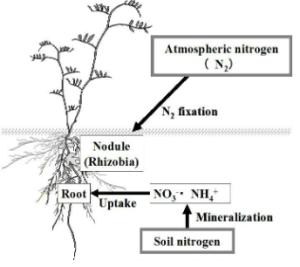A simple description of what happens with the Rhizobium bacteria is that they colonise plant cells within root nodules and convert atmospheric nitrogen into ammonia.
With the help of an enzyme known as nitrogenase, the bacteria assists the plants in obtaining organic nitrogenous compounds such as ureides and glutamine from the soil.
Nitrogenase Enzymes are a type of enzyme that breaks down nitrogen.
Nitrogenase is an enzyme that is produced by certain bacteria such as Rhizobium and Cyanobacteria, and it is responsible for the reduction of nitrogen to ammonia in the environment.
It is extremely active in anaerobic conditions and is composed of two protein subunits, non-heme iron protein and iron-molybdenum protein, which are both iron-containing.
Rhizobium structure
Rhizobium bacteria have a rod-like structure because they are members of the Bacillus group. It differs from other bacteria that are spherical or spiral in shape.
In its cell wall, it has two cell membranes that are interconnected. Rhizobium bacteria contain a variety of cell organelles, including a nucleoid (DNA), ribosomes, mesosomes, cytoplasm, and a capsule, among others. Rhizobium living outside of a plant have flagella in them, whereas those living inside a plant do not have flagella attached to their cells in the majority of cases. In the genus Rhizobium, the production of spores is referred to as sporogenesis, and it is a type of sexual reproduction that occurs in the absence of a partner.Rhizobium is a member of the Alphaproteobacteria Class, the Rhizobiales Order, and the Rhizobiacea family of bacteria.
Fixation of Nitrogen in Rhizobium
It is also referred to as biological nitrogen fixation because it involves the conversion of atmospheric or molecular nitrogen into ammonia by an enzyme known as nitrogenase.
It aids in the conversion of free nitrogen into nitrogenous salts, which in turn aids in the availability of nitrogen for plant absorption.
It is important to note that nitrogenous compounds play a significant role in plants because nitrogen is a constituent element of chlorophyll, cytochromes, alkaloids, and numerous vitamins. Different processes, such as metabolism, reproduction, growth, and heredity are influenced by the presence of this nutrient.
Nitrogen constitutes approximately 78 percent of the atmosphere’s total nitrogen content, and other nitrogenous compounds include nitrates, nitrites, and ammonia.Rhizobium nitrogen fixation is a vital biological process that occurs at the beginning of the nitrogen cycle. It is the first stage in the nitrogen cycle and is carried out by the bacteria Rhizobium.
Rhizobium is a bacteria that may be found in soil and that aids in the nitrogen fixation of leguminous plants. It attaches itself to the roots of leguminous plants and generates nodules as a result of this attachment. These nodules capture ambient nitrogen and transform it into ammonia, which can then be utilised by the plant for growth and development purposes.

Examples
Azotobacter, Cyanobacteria, Anabaena, Nostoc, and Rhizobium are some of the bacterial species that are involved in nitrogen fixation in plants.
Nitrogen fixation can also occur non-biologically, in which case microorganisms are not involved, and can be observed during lightning storms during the rainy season.
Biological nitrogen fixation can take place in a variety of ways.
- Free-living nitrogen-fixing bacteria are available.
- Cyanobacteria that fix nitrogen are free-living organisms.
- Bacteria that fix nitrogen in a symbiotic relationship.
- Cyanobacteria that fix nitrogen are free-living organisms.
Rhizobium nitrogen fixation occurs in a symbiotic relationship in nature and results in the formation of nodules in leguminous plants.
Rhizobium bacteria are a good example of symbiotic nitrogen fixation.
1.The presence of Rhizobium leguminosarum in pea plants.
2.The presence of Rhizobium phaseoli in beans
3.The presence of Rhizobium japonicum in soybeans
4.Rhizobium lupini in Lupins (Rhizobium lupini in Lupins)
Functions of Rhizobium
As previously stated, the primary function of Rhizobium is to fix atmospheric nitrogen for the plants in order to provide them with nitrogenous compounds, as well as to establish a symbiotic relationship with the plants.
Rhizobium, in addition to its other benefits, contributes to the improvement of soil productivity and fertility, thereby creating an environment conducive to plant growth.
Additionally, Rhizobium bacteria are responsible for the management of a variety of behavioural factors, such as nutrient deficiency, drought stress, salt stress, and the harmful effects of pesticides and fertilisers that may be detrimental to the plants in some way.
Applications Of Rhizobium
- Rhizobium biofertilizer is a substance that contains living microorganisms and that is applied to plant surfaces, seeds, or soil to provide nutrients to the plants.
- During this process, the Rhizobium bacteria colonise the rhizosphere or the interior of the plant in order to promote growth by increasing the supply or availability of nutrients to the host plant.
- It is through the host plant that Rhizobium is able to fix atmospheric nitrogen and convert it into useful organic compounds, which is beneficial to both the bacteria and the host plant.
Conclusion
Rhizobium is a bacterium that is commonly found in soil and plays a role in the formation of nodules after infecting the roots of leguminous plants. Consequently, they contribute to the fixation of nitrogen from the atmosphere and play an important role in the growth and development of plant life.In order for the Rhizobium bacteria to be able to fix atmospheric nitrogen on their own, they must first develop the ability to fix nitrogen as a symbiont with another organism. In this case, bacteria benefit from the plants as well, because they perform photosynthesis and prepare organic compounds that are then made available to the bacteria as well. The establishment of a mutually beneficial relationship between the plants and the rhizobium is accomplished in this manner. The roots of a legume secrete chemical attractants, and bacteria that release nod factors cause the root hairs to curl in response to the chemical attractants.
It is responsible for the degradation of the cell wall and the formation of an infection thread in the cell.
 Profile
Profile Settings
Settings Refer your friends
Refer your friends Sign out
Sign out






